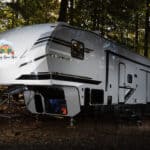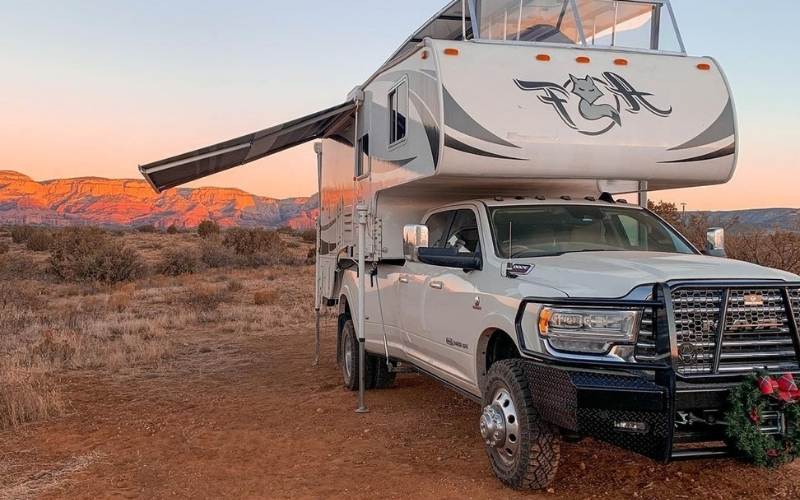Squatted trucks are customized pickup trucks with the front suspension purposefully lowered while the rear suspension remains at its original height. This alteration gives the truck a visually stunning and unusual look in which the back end sits substantially lower than the front, giving it a “squatted” attitude. Many squatted trucks have gained popularity over the years, especially models such as the squatted Ram 1500, squatted GMC Sierra, and squatted Nissan Frontier.
I’ve spent many hours wandering the great outdoors with my family, embarking on amazing adventures in our dependable squatted Ford F150. During our travels, I’ve seen an unusual automobile trend that has captivated my interest: the emergence of squatting trucks. The distinctive look of these customized trucks has drawn the attention of both fans and passersby.
Squatted trucks have acquired prominence and attracted the interest of automotive enthusiasts and even casual bystanders via social media platforms, car events, and online communities. In this article, I will dive deep into the subject of squatted trucks, their pros and cons, and how to squat your truck successfully for your next RVing outing.
The Benefits of Squat Trucks: Enhancing Your Camping Experience
Why do people squat their trucks? Many people, particularly those who have never squatted a truck, would ask why anyone would want a squatted truck. I have the answer for you.
Increased Ground Clearance
A squatted truck’s increased ground clearance becomes a great advantage when exploring hidden treasures and secluded camping areas off the usual route. It allows us to navigate harsh terrain, overcome challenging obstacles, and reach distant campsites that conventional vehicles cannot.
Improved Off-Road Performance
As an adventurous family, we regularly seek out off-road paths that lead to breathtaking scenery and natural wonders. With a squat vehicle, our off-road excursions reach new heights. With its higher rear end, the new suspension geometry lets us tackle rugged trails with greater ease and confidence, giving an incredible off-road camping experience.
Commanding Aesthetics
Our outdoor trips are not just about the destination but also the journey. With a squat truck leading the way, we attract admiring stares and spark conversations at every rest break. The distinctive look of a squatting truck adds character and personality to our camping experiences, setting the stage for unforgettable meetings with like-minded outdoor lovers.
The Essentials of Squatted Trucks
Great as they are, there are a few things you should know before you get one:
Legal Compliance
As we traverse state boundaries, knowing the legal implications of vehicle changes is critical. While squat trucks are permitted in many locations, others have particular restrictions that limit or ban extreme modifications. As a responsible camper, you must get acquainted with state legislation.
Fuel Economy
As a family that values sustainability, fuel economy is always a consideration. Squatting a vehicle might result in worse fuel economy due to inferior aerodynamics and increased wind resistance. While my enjoyment of camping is unchanged, I’m always aware of my carbon footprint and plan our holidays accordingly, considering the likely increase in fuel consumption.
Increased Wear and Tear on Suspension Components
Keeping our vehicle’s lifespan and reliability is crucial for worry-free camping. Squatting a truck places an additional load on the suspension system, particularly the rear components. This increased stress may result in quicker wear and higher maintenance costs. Regular inspections and sufficient maintenance are necessary to ensure our treasured camping buddy’s maximum performance and lifespan.
Is It Illegal to Have a Squatted Truck?
Regarding the legality of having a squatter truck, it’s vital to negotiate the different restrictions and limitations across the United States. Squat truck laws are similar to traversing rough terrain: intricate and sometimes difficult to understand. So, let’s look at the laws of squatter automobiles and discover which states permit them and which prohibit them.
To begin with, the legality of squatting automobiles depends on the specific modifications and the extent they deviate from the original manufacturer’s specifications. While specific changes may be permitted, excessive squatting may raise concerns among authorities.
Squat trucks – not to be confused with lifted trucks – are allowed in most states as long as they satisfy specific requirements and follow safety regulations. States such as California, Pennsylvania, and Virginia have placed restrictions on how far a car may be lowered, with particular standards in place to ensure road safety and prevent excessive alterations. South Carolina has an outright ban on squatted trucks.
How to Squat Your Truck
You could just squat your truck rather than search for squat trucks for sale. Squatting your vehicle entails modifying the suspension to obtain a higher front and lower back end. This step-by-step tutorial will help you through the squatting procedure for your truck.
- Choose the Right Suspension Components
- Research: Begin by studying and deciding on the best suspension components for your truck. Consider criteria such as compatibility, quality, and desired squat level.
- Suspension lift kit: Look for a suspension lift kit that is built particularly for squatting your truck. Lift blocks, enlarged rear shackles, and drop brackets are standard components included in these kits.
- Quality and safety: Select reputable manufacturers who offer suspension components that comply with safety laws. Reading reviews and asking for recommendations will help you make an informed decision.
- Install the Suspension Components
- Safety precautions: Ensure you have all the necessary tools and safety equipment. Place your truck on a level surface and engage the parking brake. Use jack stands to support the weight of the automobile during installation.
- Rear suspension: Begin with the rear suspension. Remove the existing suspension components, such as leaf springs or coil springs, as directed by the manufacturer. Install the new lift blocks or larger rear shackles according to the manufacturer’s instructions.
- Front suspension: Next, examine the front suspension. Drop brackets or adjustable torsion keys may be required depending on the equipment. Disassemble the front suspension components according to the manufacturer’s instructions and replace them as indicated.
- Adjust the Suspension Height
- Check suspension specs: See the suspension kit specs for suggested suspension height modifications. To get the intended squatting effect, follow the manufacturer’s recommendations.
- Rear suspension adjustment: The rear suspension is typically adjusted by adding or removing lift blocks or changing the shackles. To maintain balance, ensure that both sides of the rear suspension are set evenly.
- Front suspension height adjustment: Depending on the suspension setup, this may entail changing torsion keys or employing drop brackets. Follow the manufacturer’s instructions for proper adjustment to get the appropriate squatting effect while maintaining stability and alignment.
- Alignment check: After adjusting the suspension height, it is necessary to have a professional alignment check performed. Squatting the truck can cause alignment issues, resulting in uneven tire wear and poor handling. Alignment encourages peak performance and safety.
Safety Tips for Squatted Trucks
Driving a vehicle like my squatted F150 takes extra care and consideration to provide a safe and comfortable experience. Here are some critical safety precautions to take when driving your squat truck:
Be Aware of Your Environment
Squatted vehicle drivers may have poor sight in the front due to the changed suspension and stance. Squatted toy trucks may get away with this, but if you are driving a real truck, take extra precautions to be aware of your surroundings and to make good use of your mirrors.
Check your blind spots more regularly.
Slow Down
Squatted vehicles’ changed suspension can impact handling dynamics and stability. This is something to look out for, especially with a truck like the squatted Chevy Silverado. Drive at a modest speed and avoid excessive acceleration or unexpected maneuvers to retain control of your vehicle and limit the chance of an accident.
Consider your truck’s shifting center of gravity and adjust your driving technique accordingly. For safe functioning, smooth and progressive inputs are essential.
Avoid Driving In Rainy Or Icy Conditions
On icy roads, squat vehicles may have less grip and stability, particularly those with a higher rear end. Wet or slippery conditions may increase the risk of slipping or losing control. In bad weather, slow down, increase your following distances, and be extra cautious if you must drive.
Safety should always come first when you drive cars like the Carolina Squat truck. Respect traffic laws, drive safely, and customize your driving style to the specific characteristics of your vehicle. This lets you enjoy the unique look and improved off-road performance while remaining safe.
Conclusion
Following the techniques I’ve written in this article will help you enjoy your properly squatted truck. Select the necessary suspension components, and properly install them, when squatting your vehicle. Always following safety standards, such as being aware of your surroundings, driving gently, and avoiding wet or snowy situations, further improves safety when driving your pickup truck.
Consider the fuel economy, wear, and strain on suspension components, increased accident risk, and the legality of the modification in your location. Understanding local norms and legislation, as well as speaking with experts, might assist you in making an educated selection.
Do you want to know more about RVs and trucks? Head over to RVingKnowHow!
Frequently Asked Questions (FAQs)
Q: What is the point of squatted trucks?
A: Squatted trucks have a raised front end and a lower rear end. Many owners find this alteration visually appealing and distinctive. Therefore the primary aim is frequently cosmetic. Furthermore, squatting can improve off-road capability and towing or hauling performance.
Q: Why did South Carolina ban squatted trucks?
A: South Carolina officially banned squatted trucks because the authorities argued that such trucks make it difficult to see the road ahead.
Q: What is the term for squatting your truck?
A: “Squatting” is a term used to describe the alteration of raising the front end and lowering the back of a vehicle.
Q: Is the Carolina squat known by another name?
A: The Carolina squat is a common moniker for the squatting variation. It became famous for the location where this design gained prominence.
Q: Are squatted trucks illegal in Texas?
A: Squatted trucks are not technically outlawed in Texas. Certain adjustments, however, may be required to meet safety laws and preserve visibility requirements.
Q: What state has the most squatted trucks?
A: The incidence of squatting vehicles varies according to geography and subculture. It’s difficult to say which state has the most squatting trucks because no central authority records these numbers.
Q: Is it illegal to squat your truck in Georgia?
A: Vehicle modification rules vary by state and may change over time. As of September 2021, there were no specific norms or regulations in Georgia that specifically made squatting trucks illegal. However, keeping current on local regulations and checking with relevant authorities for the most up-to-date information is vital.





![The 8 Best Lightweight Truck Campers in [currentyear] 8 Best Lightweight Truck Campers](https://www.rvingknowhow.com/wp-content/uploads/2021/02/Best-Lightweight-Truck-Campers.jpg)
